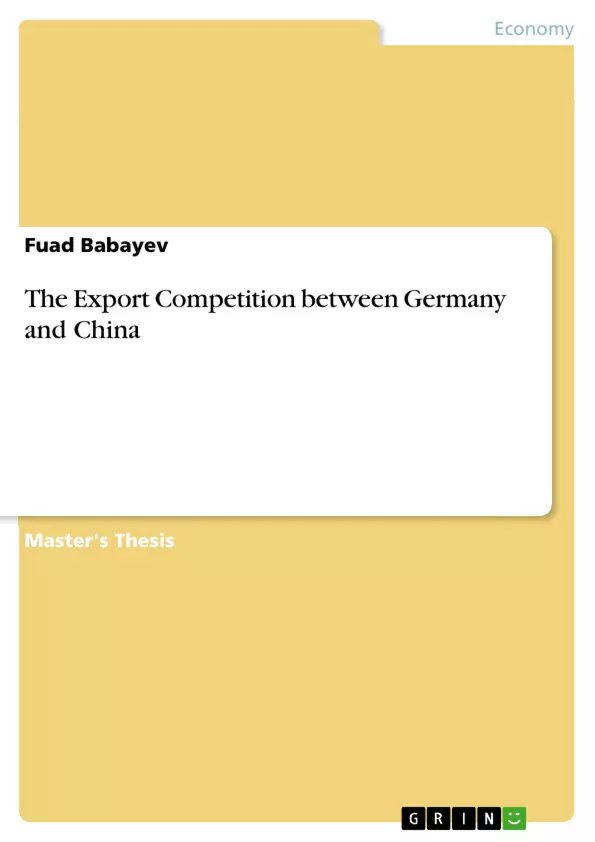This master thesis researches the export competition between Germany and China. The Russian market has been selected as an example in order to explain ongoing export competition in facts and figures. It has been noted that competition is not only about battles of winners and losers, but it is also about impact of competition on growth and innovation of the economies. Following, the thesis finds out how competition impacts the growth and innovation of theireconomy and what further actions could be taken in this regard.
The ideas regarding the impact of competition on growth and modernization are controversial in economic literature and therefore different concepts are analysed. Moreover, the competitiveness of export masters has been researched which is an important part of international trade. The competitiveness of China and Germany is considered according to several criteria, which will be mentioned later in the thesis.
Germany and China play a significant role in the world trade and they have bigger shares in imports of different states. These countries have various export strategies in the world trade and in spite of this fact both of them could be considered successful in terms of international trade. Russia is in the list of 20 biggest importers of the world where the share of imports from China and Germany comprise substantial part.
It is notable to stress the fact that since 2010 China has won leadership in Russian market over Germany who has been a number one exporter for a long time. The sales of China to Russia have ever since further increased and exceeded the volume of German exports. This ongoing competition process and its analysis through competition theory takes a core place in the thesis.
Inhaltsverzeichnis (Table of Contents)
- 1 INTRODUCTION
- 2 HYPOTHESIS FORMATION
- 2.1 METHODOLOGY
- 2.2 DESIGN OF THE THESIS
- 3 LITERATURE VIEW
- 3.1 THEORETICAL FOUNDATION
- 3.2 COMPETITION AND INNOVATION
- 3.3 COMPETITION AND GROWTH
- 3.4 COMPETITIVENESS
- 4 GERMAN AND CHINESE EXPORT ECONOMY
- 4.1 COMPETITIVENESS OF GERMANY AND CHINA
- 4.2 THE EXPORTS OF GERMANY TO RUSSIA
- 4.3 THE EXPORTS OF CHINA TO RUSSIA
- 4.4 COMPETITION OF GERMAN AND CHINESE FIRMS IN RUSSIAN MARKET
- 5 ANALYSIS OF THE THEORIES OF COMPETITION AND INNOVATION
- 5.1 DOES THE EXPORT COMPETITION BETWEEN CHINA AND GERMANY CONTRIBUTE TO THE INNOVATION OF THEIR ECONOMIES?
- 5.2 ARE BOTH ECONOMIES ENOUGH COMPETITIVE IN ORDER TO CO-EXIST?
- 5.3 IS CHINA A THREAT FOR GERMAN EXPORTS?
- 6 MEETING CHALLENGES OF COMPETITION IN GLOBAL ECONOMY
- CONCLUSION
Zielsetzung und Themenschwerpunkte (Objectives and Key Themes)
This master thesis examines the export competition between Germany and China, using the Russian market as a case study. It aims to analyze the impact of competition on economic growth and innovation, exploring how competition affects the growth and innovation of the German and Chinese economies. The thesis further examines the competitiveness of both countries in the international trade context and investigates the implications of China's growing presence in the Russian market for German exports.
- Export competition between Germany and China
- Impact of competition on economic growth and innovation
- Competitiveness of German and Chinese export economies
- China's growing presence in the Russian market
- Implications for German exports
Zusammenfassung der Kapitel (Chapter Summaries)
- Chapter 1: Introduction provides a brief overview of the research topic and its relevance. It highlights the significance of export competition between Germany and China, particularly in the context of the Russian market.
- Chapter 2: Hypothesis Formation outlines the methodology and design of the thesis. It defines the key research questions and hypotheses that will be addressed throughout the study.
- Chapter 3: Literature View reviews existing theoretical frameworks and empirical evidence related to competition, innovation, growth, and competitiveness. This chapter provides a foundation for the analysis presented in subsequent chapters.
- Chapter 4: German and Chinese Export Economy analyzes the competitiveness of both countries in the global trade landscape. It examines their export strategies, performance, and key export sectors. The chapter then focuses on the Russian market, detailing the exports of Germany and China to Russia and the dynamics of their competition within this market.
- Chapter 5: Analysis of the Theories of Competition and Innovation applies theoretical frameworks from the literature review to analyze the impact of competition on innovation and growth in the German and Chinese economies. This chapter examines whether the export competition between the two countries contributes to their innovation and whether both economies are competitive enough to co-exist.
- Chapter 6: Meeting Challenges of Competition in Global Economy explores the challenges and opportunities faced by Germany and China in the global economy. It discusses strategies to navigate the competitive landscape and address future challenges.
Schlüsselwörter (Keywords)
This master thesis explores the export competition between Germany and China, focusing on the Russian market. It examines key themes such as economic growth, innovation, competitiveness, and export strategies. The study explores the impact of competition on the growth and innovation of both economies and analyzes the competitiveness of both Germany and China in the global trade context.
- Quote paper
- Fuad Babayev (Author), 2014, The Export Competition between Germany and China, Munich, GRIN Verlag, https://www.grin.com/document/413445



